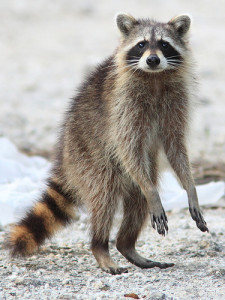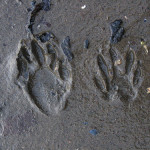Signs That You May Have Raccoons in Your Attic!
By Chris Williams on January 9, 2015.
My husband thinks we have a raccoon nesting in our attic. The other guess was a squirrel but we’ve never seen any squirrels around our property. What are some signs of raccoons? When he checks up there, the animal is gone but we keep hearing the noise later. P. T., Melrose, MA
 In Massachusetts and New Hampshire, raccoons will den up and become less active during the winter, although they don’t hibernate completely. They normally den in hollow trees, rock crevices, or other animals’ nests, but sometimes that winter den choice might be an attic or chimney in a home. Here are some clues that might mean a raccoon is nearby:
In Massachusetts and New Hampshire, raccoons will den up and become less active during the winter, although they don’t hibernate completely. They normally den in hollow trees, rock crevices, or other animals’ nests, but sometimes that winter den choice might be an attic or chimney in a home. Here are some clues that might mean a raccoon is nearby:
Noise
Raccoons are large animals and can make a lot of noise when lumbering around in your attic. They have various cries, grunts, barks, and growls that they make when feeding or when threatened, but you probably won’t hear those from the attic. You might hear noises in your yard when the raccoon is out of the attic. Young raccoons make a chittering noise that can be mistaken for birds.
Tracks
Check in your yard if there is soft dirt, or check in your attic if it’s dusty, for tracks that show a flatfooted paw with 5 toes. The front paw print is about 2 inches wide by 2 inches long. The hind paw print is longer, about 4-inchs, and looks more like a tiny human footprint with long toes.
Poop (Scat)
Raccoons leave feces or scat at the base of trees, on logs or big rocks, on woodpiles, or on the roof and in the attic. Raccoon feces can contain roundworms that can be transmitted to people (see Raccoons Can Be Hazardous to Your Health). Don’t try to clean up raccoon scat without special precautions, including a respirator.
Damage to Buildings
Raccoons can leave black smudge marks on walls or downspouts from oils in their hairs. They mostly enter homes at the roofline by using tree branches or downspouts and then pushing their way through louvers or soffits, or they may climb directly up the siding. They cause damage when they try to create or enlarge entry holes, bend downspouts or gutters, chew holes in siding, rip off boards and shingles, and damage soffits or vent louvers.
Inside attics, raccoons can tear up insulation and might rip insulation off of pipes or ducts to use for nesting material. They can cause a fire hazard when they chew on wires. They use one area in the attic as a latrine; accumulated urine will smell and can leak through the ceiling below. Do not try to clean up a raccoon’s latrine without special precautions.
Damage in the Yard
Raccoons are notorious for knocking over and damaging garbage cans (see Keeping Raccoons Out of Your Garbage Cans). They will pull down and damage bird feeders or animal feeders. Raccoons will dig up garden crops and can do considerable damage to lawns when they dig for grubs and worms.
You need to have a professional inspect your attic and yard. Whether the culprit is a raccoon or a squirrel, we can trap and remove the offender and then can seal and screen openings, and make your home raccoon-proof. In Massachusetts and New Hampshire, raccoon breeding season is January-March with young born in April or May. Removing a single female raccoon from your attic is a lot easier (for everyone!) than removing a whole family! Give us a call.
Photo credit: Kenneth Cole Schneider / Foter / CC BY-ND
Photo credit: GerryT / Foter / CC BY
Stay up-to-date with Colonial Pest’s email newsletter!
